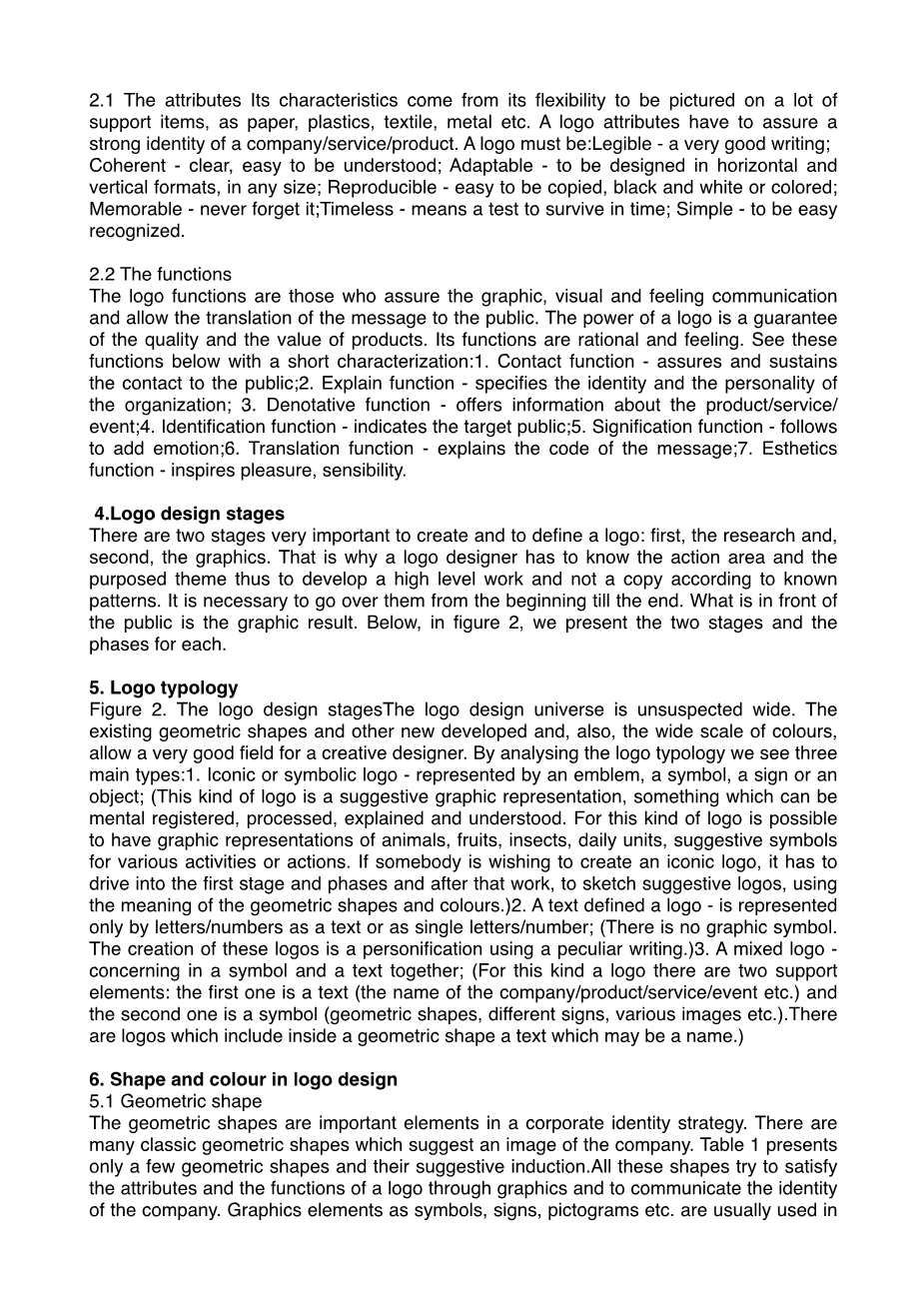英语原文共 3 页,剩余内容已隐藏,支付完成后下载完整资料
Logo design and the corporate identity
Abstract:
This paper presents the importance of a logo as a graphic element to support a corporate identity. A logo is a graphic identity vector and it has its place in a communication strategy of a company. It is about the signature of a company. That is why is very important to be able to create a harmony between colours and shapes concerning the universe of logos. There are two stages: first, the research and market projection and the second, the creative graphic work. These two stages achieve the possibility to make a logo lifting” when is necessary.
1. Introduction
First of all we have to see what a logo is. It is a symbol, a graphic and visual sign which plays an important role into the communication structure of a company. A logo is a clear graphic element which make possible to distinct between companies. A logo is a signature of a company, may be like a new conception, a certain life style etc. It is about a bridge between the public and the company. It conveys details in a very concentrate graphic representation. It is a possible sign to compare similar items. That is why to create a logo is not a happening, is a consequence of very specified analyses, concerning geometric shapes, colours, various signs and symbols, all into an harmonious mixture which is driven to catch and to be part of people#39;s mind.
2. Logo application domains
Its domain is so wide. Shortly, someone see this graphic symbol in social, economic and political life. Bellow there are specified only a few domains:2. Legality and law (office copy, advocates, insurance, justice, associations, foundations, political parties etc.); 2. Education and culture (universities, schools/high schools/colleges/libraries/bookstores etc.3. Transport activities (driving schools, taxies, transport companies, auto brands, car parts stores etc.);4. Constructions and development programs (construction materials, decorations, furniture, solar energy,equipments and hardware etc.);5. Medical activities/pharmaceutics (medical clinics, health spas, drugstores, specialized cabinets etc.);6. Cosmetics and spa treatments (cabinets and body wellness salons, fitness, cosmetics, hairstyle, barber shops, spa amp; beauty salons etc.);7. Food industry (candy shop/pastry shop, coffee shop, restaurant/pub/bar, tea house, catering etc.);8. Media amp; Advertising (media network, TV cable, TV company, audio company, advertising/commercials etc.);9. Sports and sports equipment (sports clubs, sporting events, sports, sport fashion stores, etc);10. Financial-banking activities (banks, financial-banking consulting firms, exchange offices etc.);11. Varied services (tourism/travel, recreation activities, auto service, car wash, vulcanization shop, auto garage,supermarket, cleaning, sanitation, utilitarian mountain climbing, telecommunications, internet/software etc.). For these activities there are necessary proper symbols. For example:justice: law books, the justice scale, the Constitution, a person pleading etc.; - travel: landscapes, boats, trucks, beach, sea, mountains, cottage etc.;- auto: cars, wheel, tyres, body car parts, dash board etc.;- pet shop/vet medical care: domestic and savage animals.an harmonious mixture which is driven bdquo;to catch” and to be part of people#39;s mind.
3. The attributes and the functions of a logo
2.1 The attributes Its characteristics come from its flexibility to be pictured on a lot of support items, as paper, plastics, textile, metal etc. A logo attributes have to assure a strong identity of a company/service/product. A logo must be:Legible - a very good writing;
Coherent - clear, easy to be understood; Adaptable - to be designed in horizontal and vertical formats, in any size; Reproducible - easy to be copied, black and white or colored; Memorable - never forget it;Timeless - means a test to survive in time; Simple - to be easy recognized.
2.2 The functions
The logo functions are those who assure the graphic, visual and feeling communication and allow the translation of the message to the public. The power of a logo is a guarantee of the quality and the value of products. Its functions are rational and feeling. See these functions below with a short characterization:1. Contact function - assures and sustains the contact to the public;2. Explain function - specifies the identity and the personality of the organization; 3. Denotative function - offers information about the product/service/event;4. Identification function - indicates the target public;5. Signification function - follows to add emotion;6. Translation function - explains the code of the message;7. Esthetics function - inspires pleasure, sensibility.
4.Logo design stages
There are two stages very important to create and to define a logo: first, the research and, second, the graphics. That is why a logo designer has to know the action area and the purposed theme thus to develop a high level work and not a copy according to known patterns. It is necessary to go over them from the beginning till the end. What is in front of the public is the graphic result. Below, in figure 2, we present the two stages and the phases for each.
5. Logo typology
Figure 2. The logo design stagesThe logo design universe is unsuspected wide. The existing geometric shapes and other new developed and, also, the wide scale of colours, allow a very good field for a creative designer. By analysing the logo typology we see three main types:1. Iconic or symbolic logo - represented by an emblem, a symbol, a sign or an object; (This kind of logo is a suggestive graphic representation, something which can be mental registered, processed, explained and understood. For this kind of logo is possible to have graphic representations of animals, fruits, insects, daily uni
全文共27433字,剩余内容已隐藏,支付完成后下载完整资料
资料编号:[14083],资料为PDF文档或Word文档,PDF文档可免费转换为Word
以上是毕业论文外文翻译,课题毕业论文、任务书、文献综述、开题报告、程序设计、图纸设计等资料可联系客服协助查找。




